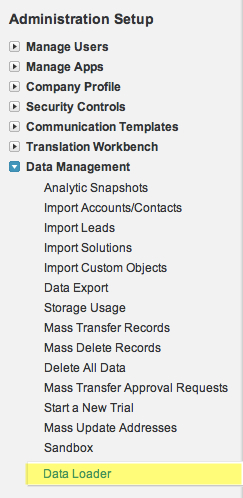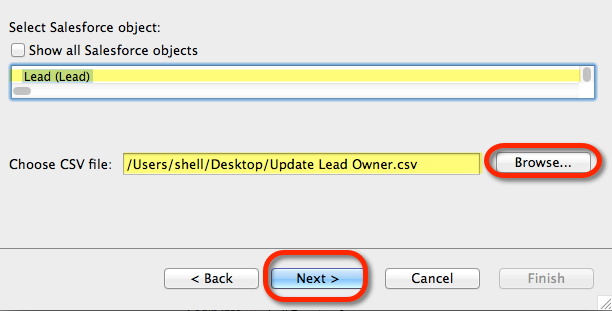Data Loader v45.0.0 built with Zulu OpenJDK 11; Launch scripts to help end users launch Data Loader for Windows and macOS; Configuration and log setting files in the Data Loader installation folder; This version uses the upgraded Salesforce Force Partner Api and Force WSC v45. Downloading Data Loader from Salesforce. Data loader can be downloaded from data management. Go to Data Management Data Loader. Click on Data Loader and select the Operating system to which you want to download. Now Apex Data Loader will download in to our local system. Install latest Java version in to your local system.
- Download Data Loader Salesforce For Mac Windows 10
- Salesforce Data Loader Tool
- Data Loader For Salesforce
- Download Data Loader Salesforce For Mac Osx
- Data Loader Salesforce App
Everyday millions of people around the world use Outlook and Salesforce to help run their businesses. In Office 2013, we introduced Apps for Office to let our partners add capabilities to Office to extend it and integrate it with the services our users use every day to help them be even more productive in Office.
Microsoft Outlook
Connect. Organize. Get things done.
Get OutlookToday, as part of our ongoing strategic partnership with Salesforce, the new Salesforce App for Outlook was announced to give users a great new way to work with Salesforce right from within Outlook. This lets users view Salesforce contacts, leads, accounts and opportunities in the context of an email from a customer. Salesforce for Outlook works with Outlook 2013, Office 365, Outlook for Mac and the Outlook Web App (OWA).
You can read the full announcement from Salesforce as well as more about the app here.
You can get the Salesforce App for Outlook from the Office Store for free: store.office.com.
Jim SimonWelcome back! This is the second blog in an evolving series around Salesforce.com data loader tools. In case you missed it, please checkout my first blog “5 Best Practices for Salesforce.com Apex Data Loader”.
Salesforce data-loading tools have been around for a while and there’s a lot to chose from these days. How do you make sense of them? Which ones do you use? There’s a whole slew of them now on the AppExchange, but today we are going to look at 5.
This idea is not new; I’m just circling back around to this topic to give my perspective. In fact, there are other great blogs such as “Comparing Data Loaders for Salesforce” (2013) by Roger Mitchell and “Best Data loader for Salesforce” (2014) by Ben McCarthy.
There are so many tools out there today, but what do you use? It all depends on what you want to accomplish and who is going to do the work. In order to determine what tool you want to use depends on a few key factors:
• Your audience– tech savvy or non tech savvy
• How often you need to load– one-off load, routine, integration/automated, etc
• How many records you need to load
• What Salesforce objects you need to load to.
Note: I am making an assumption that the correct permissions are set up for the users to import data where they need, if not, you will need to understand your Salesforce security model in advance.
Let’s get started!
1. Salesforce Apex Data Loader

The standard Salesforce Data Loader is the tool of choice for most, business users and consultants alike. It’s powerful, convenient and well documented. This tool is best used for repetitive data loads by business users or data migration projects.
Download Data Loader Salesforce For Mac Windows 10

Pros: Pretty fast compared to other tools; a lot of flexibility to throttle batch sizes; Can load up to 5 million records; Powerful CLI tools; Ability to schedule recurring data loads and since it’s installed locally you can install on a server and use as an integration tool for on premise systems; Ability to match on external IDs.
Cons: Can be annoying to install on a Mac; Auto mappings can be a bit quirky, sometimes leading to wrong mappings or missing fields in the UI altogether; Can only import CSV files.
2. Dataloader.io
Dataloader.io is one of the most popular tools on the market today, and I generally recommend this tool to most of my clients. It’s very intuitive and wizard driven. I like the fact you can save your data loading jobs.
Pros: 100% cloud-based, no installation required; doesn’t require security token; Support for DropBox, Box, SFTP and FTP; Scheduling jobs.
Cons: Can be a little slower than the Salesforce Apex Data Loader; If you just want to do a quick one off data load this might take a little longer to setup than standard Salesforce Apex Data Loader.
Salesforce Data Loader Tool
3. Salesforce Data Import wizard
The Import Wizard is native to Salesforce and is accessed from within. It is used to import records into many standard objects such as Leads, Accounts, Contacts, Solutions and custom objects. As the name implies, it is wizard-driven.
Pros: Easy for repetitive tasks for business users to import Leads–which is the most popular use of this tool especially if you have a formatted external data set you routinely load; See this Trailhead module to learn more.
Cons: Can only import up to 50,000 records; CSV files only.
4. Jitterbit Data Loader
Jitterbit is the free data loader offering by Jitterbit as entry to their full integration suite. I generally only recommend this tool if someone needs to have local database connectivity or integration and is a tech savvy user. I will admit I don’t use this tool much, and I’m sure it has a lot of great use cases.
Pros: Loading any flat file, any ODBC or JDBC database; repetitive loads; basic scripted ETLs and basic integration.
Cons: I don’t find the user interface as intuitive as Dataloader.io; cumbersome for one-off loads; not 100% cloud based as the name would suggest but requires local client to be installed.
5. Informatica Cloud Data Loader
Informatica is know as a powerful integration suite and the Cloud Data Loader is an entry into the full offering that has some neat capabilities. I recommend this tool for those who want to do above basic data transformations as they load.
Pros: What they call “built-in intelligence” where it will format your data fields to the Salesforce support format–when using the standard Salesforce Data Loader, you must transform your date fields; prebuilt integration templates for systems such as NetSuite or SAP; Allow for on the fly data transformations; Connects to Box.
Cons: CSV files only; a bit cumbersome to learn and understand; not for non tech savvy users.
In the end, these tools accomplish the same thing; they get data in and out of Salesforce. You need to decide what’s the best tool for you to accomplish this. I hope that with all the information listed above it helps make your decision easier.
Stay tuned for my next blog where I talk about leveraging Salesforce Data Loader and other related tools to backup Salesforce such as: DBAmp, SQL server, Ownbackup, and Salesforce weekly exports.
July 26, 2016
Related Posts
Data Loader For Salesforce


October 15, 2020
Salesforce Winter 2021 Release Features We Can’t Wait To Use!
Sebastian ToplicianSeptember 16, 2020
How to get started with CPQ?
Kyle ChagnonDownload Data Loader Salesforce For Mac Osx
July 30, 2020
The Modern Tech Stack is Broken
Kyle ChagnonData Loader Salesforce App
Leave a Comment
